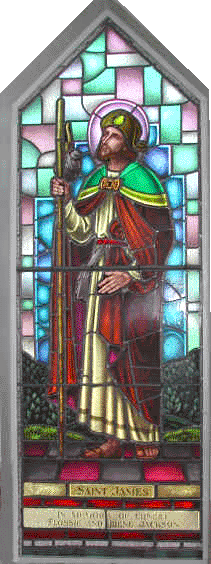Saint James
Apostle and Martyr
25 July
 James the son of Zebedee
and his brother John were among the twelve disciples of Our Lord. They, together
with Peter, were privileged to behold the Transfiguration,
to witness the healing of Peter's mother-in-law and the raising of the daughter
of Jairus, and to be called aside to watch and pray with Jesus in the garden
of Gethsemane on the night before His death.
James the son of Zebedee
and his brother John were among the twelve disciples of Our Lord. They, together
with Peter, were privileged to behold the Transfiguration,
to witness the healing of Peter's mother-in-law and the raising of the daughter
of Jairus, and to be called aside to watch and pray with Jesus in the garden
of Gethsemane on the night before His death.
James and John were apparently from a higher social level than the average fisherman. Their father could afford hired servants, and John (assuming him to be identical with the "beloved disciple") had connections with the high priest. Jesus nicknamed the two brothers "sons of thunder", perhaps meaning that they were headstrong, hot-tempered, and impulsive; and so they seem to be in two incidents reported in the Gospels. On one occasion, Jesus and the disciples were refused the hospitality of a Samaritan village, and James and John proposed to call down fire from heaven on the offenders. On another occasion, they asked Jesus for a special place of honour in the Kingdom, and were told that the place of honour is the place of suffering.
Finally, about AD 42, shortly before Passover, James was beheaded by order of King Herod Agrippa I, grandson of Herod the Great (who tried to kill the infant Jesus), nephew of Herod Antipas (who killed John the Baptist and examined Jesus on Good Friday), and father of Herod Agrippa II (who heard the defence of Paul before Festus). James was the first of the Twelve to suffer martyrdom, and the only one of the Twelve whose death is recorded in the New Testament.
James is often called James Major (i.e., greater or elder) to distinguish him from other New Testament persons called James. Tradition has it that he made a missionary journey to Spain, and that after his death his body was taken to Spain and buried at Compostela. His supposed burial place there was a major site of pilgrimage in the Middle Ages, and the Spaniards fighting to drive their Moorish conquerors out of Spain took "Santiago de Compostela!" as one of their chief war-cries.
Acknowledgements:
Text adapted from James Kiefer's Christian Biographies
Image from Saint James' Church, Manotick